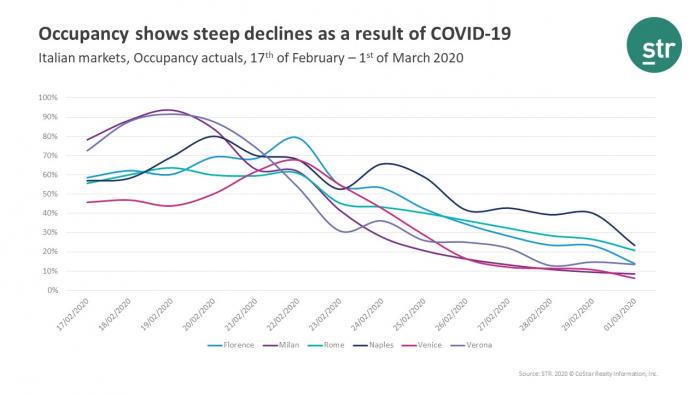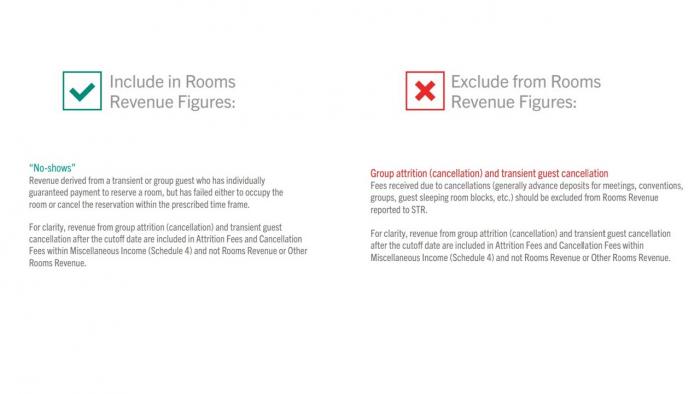Over the last week, Italy has become a focal point of the COVID-19 outbreak. And to no surprise, the hotel performance impact has been significant when examining preliminary data for regions of the country. It is important to note that performance declines are more pronounced in Italy in comparison with other countries due to the significant measures being taken by the government to combat the virus spread. The hope is that these measure will position Italy to rise from the situation earlier than other countries in order to offer a safe European destination for summer travelers.
COVID-19: Impact on Italy hotel performance

The first cases of coronavirus in Italy were reported in Codogno—a small village just 60km out of Milan. The virus then spread quickly around the northern region with a majority of cases in Lombardia and Veneto, the Milan and Venice regions, respectively.
Milan
We note the presence of Fashion Week from 18-24 February and a hotel occupancy peak of 93% on the 18th. There had been restrictions put in place for Fashion Week with restricted access and viewership limited to live streaming video. Then beginning on 22 February, we see downward movement in occupancy, which fell to an absolute level as low as 8.5% on 1 March. On 23 February, Milan closed schools, gyms, museums and other major cultural attractions, including the Duomo. Initially, this closure was set for a week, but latest news reports point to an extended closure to 15 March. The Milan region, Lombardia, shows one of the highest number of COVID-19 cases across the country—1,500 at the moment.
Venice
Carnival celebrations, planned for 8-25 February, were cut short, and a steep occupancy decline that began around the 24th dropped absolute occupancy to below 7% on 1 March.
Florence
A downward trend in occupancy became most noticeable around the 25th, and as of 1 March, occupancy was at 14%.
Rome
Further away from the epicenter of the outbreak, Rome has also experienced declines in performance. From the middle of last week, we see downward occupancy begin around the middle of last week, ending with absolute occupancy at 21% as of 1 March. Of note, Rome has reported far fewer cases than the northern part of Italy—only 14 registered cases across the entire region of Lazio as of 4 March.
Average daily rate (ADR)
Despite the significant declines in occupancy, we are not seeing much movement in ADR across these same markets. Please remember, any no-show revenue will be accounted for in this data.
The current approach for the inclusion/exclusion of no-show revenue is set forth by the USALI Revised 11th Edition. STR’s Data Reporting Guidelines also reflect this guidance as highlighted below.
Other Rooms Revenue
Other Rooms Revenue is miscellaneous revenue associated with guestrooms. This revenue is included in determining Total Rooms Revenue and is used in the calculation of average daily rate (ADR). Items associated with Other Rooms Revenue include:
- No-shows. This is revenue derived from a transient or group guest who has individually guaranteed payment to reserve a room, but has failed to occupy the room. No room nights are to be recorded for a no-show. Group attrition and cancellation and transient guest cancellation after the cutoff date are included in Attrition Fees and Cancellation Fees on Miscellaneous Income — schedule 4, not Other Rooms Revenue.

STR’s full Data Reporting Guidelines can be found here.
Like other parts of the world, we will continue to monitor the situation in Italy as cases have now reached even the country’s southern regions. The Naples region (Campania) now has a total of 30 cases, and there are several cases even in Puglia, Sicily and Calabria.
As of 4 March, Italy had reported 2,502 COVID-19 cases—the fourth most after China, South Korea and Iran. It is interesting to note that of the many direct flights between Europe and China, Italy represented on a small percentage.
In recent days, the country implemented a two-week school closure and noted that all sports events—Serie A—can only be done behind closed doors for 30 days. The measures will be effective until 3 April.